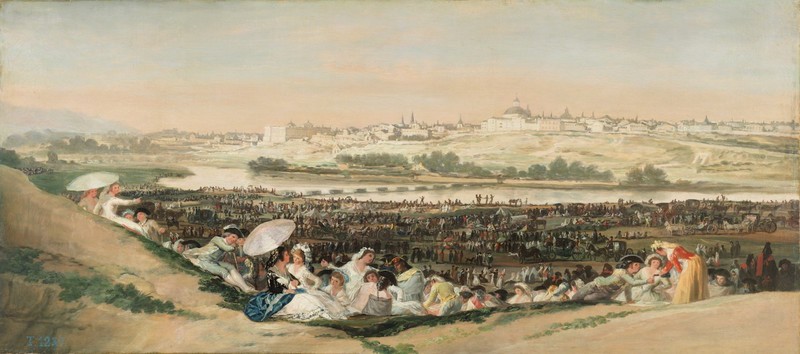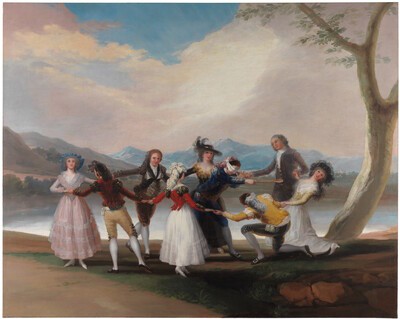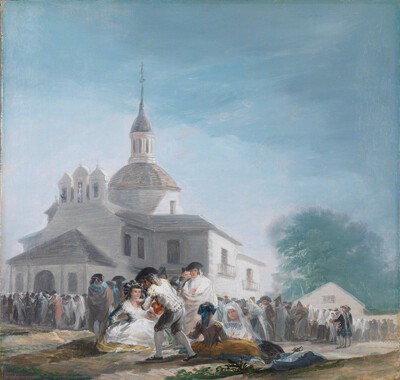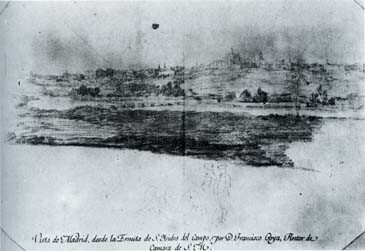- Cronología
- 1788
- Ubicación
- The Prado National Museum. Madrid, Madrid, Spain
- Dimensiones
- 41.9 x 90.8 cm
- Técnica y soporte
- Oil on canvas
- Reconocimiento de la autoría de Goya
- Documented work
- Titular
- El Prado National Museum
- Ficha: realización/revisión
- 17 Dec 2009 / 14 Jun 2023
- Inventario
- (P00750)
The tapestry cartoon for which this sketch was made was never in fact painted. It formed part of the series that would have decorated the bedroom of the Infantas, a commission that Goya received towards the end of 1787 (see Blind Man's Buff).
The sketch was acquired from the artist by the Duke and Duchess of Osuna in 1798 and it remained in the cabinet that the Duchess had in La Alameda until it was sold at the time of the bankruptcy of the ducal household in 1896, when it was bought for the Prado Museum by the Spanish Ministry of Development, for the sum of 15,000 pesetas. It entered the museum's collection on 5 June 1896.
Intended to become a tapestry cartoon, this work never got any further than the oil sketch, thereby preventing the creation of what would without a doubt have been the largest canvas ever painted by the artist, as well as one of his greatest. Unfortunately, the death of Charles III in December 1788 interrupted the work on the décor of the palace of El Pardo, which the royal family stopped using shortly afterwards.
This painting has been highly praised. Arnaiz highlights the complexity of its composition, its rapid, fresh execution and its precise colouring. Camón Aznar says that not even the Venetians of the 18th century were able to create such a delicate overall effect.
On the skyline we can make out the silhouettes of the Segovia bridge, the church of San Francisco el Grande and the Alcázar Nuevo. This is a place very familiar to Goya thanks to the proximity of the Royal Palace and the home of the Duke and Duchess of Osuna. Years later, the artist's own home - the Quinta del Sordo - was also very close to this spot.
The way in which the canvas is composed recalls the work of other artists that Goya may have drawn inspiration from, such as View of Zaragoza, by Juan Bautista Martínez del Mazo; The Royal Couples by Luis Paret; certain vedute, or views, of Madrid painted by Antonio Joli; and the work of the French artist Claude-Joseph Vernet.
The subject matter of religious celebrations attracted the attention of politicians, intellectuals and other artists, as well as painters. In the sainete, or short comical play, of the same name by Ramón de la Cruz we find a magnificent literary parallelism to Goya's representation of the fiesta of San Isidro Labrador. In Ramón de la Cruz's work, the distinct social groups are played off against each other, whilst in that of Goya they appear to mingle amicably. The ilustrados with whom the artist was on very friendly terms were opposed to celebrations of this kind as they would often degenerate into quarrels in which the authorities were forced to intervene. However, the image that Goya offers us of this particular celebration is an idyllic one.
The sketch for The Meadow of San Isidro had given Goya quite a few problems. The artist wrote in a letter to his friend Martín Zapater that he had had to work hard on the difficult matter of the meadow on the saint's day, with all of the hustle and bustle that the work involved. In fact, the sketch presents a great variety of colour and countless figures, leading writers such as Mayer and Beruete to consider that this could not possibly be a sketch for a cartoon that would be transferred to a tapestry. However, if we take into account the dimensions specified by the carpenter Serrano for the stretcher that Goya would have used for the finished cartoon, 348 x 752 cm, there would have been enough space to fit in even all these tiny details. Furthermore, just as with the only cartoon in this series actually to be executed,Blind Man's Buff, Goya would have simplified the composition slightly to facilitate the work of the tapestry weavers.
Restored in 1987. Conserved unlined and on the original stretcher
-
Exposición y venta de los cuadros, esculturas, grabados y otros objetos artísticos de la Casa DucaPalacio de la Industria y de las ArtesMadrid18961896cat. 66
-
Les chefs-d’œuvre du Musée du PradoMusée d’Art et d’HistoireGeneva1939consultant editors Fernando Álvarez de Sotomayor y Pedro Muguruza Otaño. From June to September 1939cat. 29
-
El arte europeo en la corte de España durante el siglo XVIIIGalerie des Beaux-ArtsBurdeos1979Exhibitied also at Grand Palais, París y Museo Nacional del Prado, Madridcat. 21 (17)
-
Obras maestras de la pintura española de los siglos XVI al XIXMuseo PushkinMoscow1980Exhibited also at the State Hermitage Museum, San Petersburgocat. 28
-
Goya y el espíritu de la IlustraciónMuseo Nacional del PradoMadrid1988from October 6th to December 18th 1988. Exhibited also at Museum of Fine Arts, Boston, January 18th to March 26th 1989; The Metropolitan Museum of Art, Nueva York, May 9th to July 16th 1989, Madrid curator Manuela B. Mena Marqués, scientific directors Alfonso E. Pérez Sánchez and Eleanor A. Sayrecat. 16
-
Madrid pintado. La imagen de Madrid a través de la pinturaMuseo Municipal de MadridMadrid1992cat. 51
-
Goya. El Capricho y la Invención. Cuadros de gabinete, bocetos y miniaturasMuseo Nacional del PradoMadrid1993from November 18th 1993 to February 15th 1994. Exhibited also at the Royal Academy of Arts, London, March 18th to June 12th 1994 and The Art Institute of Chicago, Chicago, July 16th to October 16th 1994, consultant editors Manuela B. Mena Marqués and Juliet Wilson-Bareaucat. 26
-
Goya. 250 AniversarioMuseo Nacional del PradoMadrid1996consultant editor Juan J. Luna. From March 29th to June 2nd 1996cat. 49
-
Goya en Madrid. Cartones para tapices 1775-1794Museo Nacional del PradoMadrid2014p. 133
-
Goya: Order and disorderMuseum of Fine ArtsBoston2014cat. 223
-
L'œuvre peint de Goya. 4 volsParís1928-1950vol. I, p. 204, cat. 166
-
Tapices de GoyaMadridPatrimonio Nacional1946pp. 155, 264, cat. 53 y láms. 166-169
-
Vie et ouvre de Francisco de GoyaParísOffice du livre1970pp. 66-67, 79, 98, cat. 272
-
BarcelonaPolígrafa1970vol. I, p. 274, cat. 252
-
L’opera pittorica completa di GoyaMilanRizzoli1974103, cat. 231
-
Francisco de Goya, 4 vols.ZaragozaCaja de Ahorros de Zaragoza, Aragón y Rioja1980-1982vol. II, p. 59 y p. 113 (il.)
-
Francisco de Goya, cartones y tapicescol. col. "Espasa Arte"Espasa Calpe1987pp. 154-155, 178, 182, 305, cat. 58B; p.
-
Goya. El capricho y la invención. Cuadros de gabinete, bocetos y miniaturasMadridMuseo del Prado1993pp. 172-174, 356, cat. 26 y pp. 176, 177
-
Francisco de Goya. Los cartones para tapices y los comienzos de su carrera en la corte de Madridcol. col. "Ensayos de Arte Cátedra"MadridCátedra1987pp. 232-234 y p. 232 (il.)
-
Goya. 250 AniversarioMadridMuseo del Prado1996p. 328, cat. 49 y pp. 128-129 (ils.)
-
Salas del Palacio Real de El Pardo para las que se tejieron tapices sobre cartones de Francisco de Goya: identificación de las habitaciones y ajuste de las obras de Goya en los alzados de las paredesin HERRERO CARRETERO, Concha (curator, Tapices y cartones de Goya (catalogue of the exhibition organizated at the Palacio Real de Madrid, from may to june 1996)MadridPatrimonio Nacional, Goya 96, Lunwerg1996p. 173 (il.)
-
Goya en Madrid. Cartones para tapices 1775-1794MadridMuseo Nacional del Prado2014p. 133-135
-
Goya: Order & DisorderBostonMuseum of Fine Arts Boston Publications2014pp. 320-324




